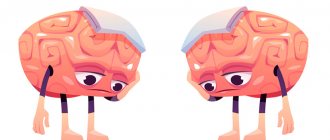This block includes a number of mental disorders grouped together due to the presence of clear etiological factors, namely the cause of these disorders is brain disease, brain injury or stroke leading to cerebral dysfunction. Dysfunction can be primary (as in diseases, brain injuries and strokes that directly or selectively affect the brain) and secondary (as in systemic diseases or disorders when the brain is involved in the pathological process along with other organs and systems)
Dementia (F00-F03) is a syndrome caused by brain damage (usually chronic or progressive) in which many higher cortical functions are impaired, including memory, thinking, orientation, comprehension, numeracy, learning, speech and judgment . Consciousness is not darkened. Decline in cognitive function is usually accompanied, and sometimes preceded, by deterioration in emotional control, social behavior, or motivation. This syndrome is observed in Alzheimer's disease, cerebrovascular diseases and other conditions that primarily or secondarily affect the brain.
If necessary, an additional code is used to identify the original disease.
Dementia.
G1. Both characteristics are required:
Psychology bookap
1) Memory deterioration, most noticeable in the area of assimilation of new information, although in more severe cases the reproduction of previously acquired information may also be impaired. The disorder concerns both verbal and nonverbal material. Memory decline should be confirmed by an objectively reliable history from the informant and, if possible, supplemented by neuropsychological testing or quantitative assessment of cognitive abilities. Levels of severity of memory impairment should be assessed as follows (mild memory impairment is the diagnostic threshold):
Mild memory disorder. Daily activities are difficult, although independent living is still possible. It is mainly the assimilation of new material that is disrupted. For example, there may be difficulties in daily life in recording, storing and reproducing the location of household objects, social arrangements, or information received from relatives.
Moderate disorder. Memory impairment represents a serious obstacle to daily life. Only very well learned or very familiar material is retained. New information is retained only occasionally or for a very short time. The patient is unable to remember basic information about where he lives, what he has done recently, or the names of his acquaintances.
Psychology bookap
Severe disorder. This degree of memory impairment is characterized by a complete inability to assimilate information. The patient is unable to recognize even close relatives.
2) Decline in other cognitive abilities is characterized by a decline in critical thinking and thinking, such as in planning and organizing, as well as a decline in general information processing.
Confirmation of this should be based, if possible, on an objective history and, if possible, supplemented by neuropsychological tests or quantitative objective assessments. There must be a deterioration in comparison with the previous higher level of productivity. The degree of reduction should be assessed as follows (the diagnostic threshold is mild impairment):
Psychology bookap
Mild violation. A decrease in cognitive abilities causes impairment in productivity in everyday life, but does not make the patient dependent on others. More complex daily tasks and leisure activities are not possible.
Moderate violation. Decreased intellectual ability makes it impossible to function in everyday life without assistance, including shopping and handling money. Only simple work can be done within the house. Interests are very limited and poorly supported.
Serious violation. The impairment is characterized by the absence or virtual absence of rational thinking.
Psychology bookap
The overall severity of dementia is best determined by the level of memory OR intellectual impairment, whichever is more severe (eg, mild memory impairment and moderate intellectual impairment are rated as moderate dementia).
G2. Absence of confusion (as in criterion A in F05) for a period of time sufficient to clearly identify
G1. If episodes of delirium occur in the setting of dementia, the diagnosis of dementia should be rejected.
Psychology bookap
G3. Decreased emotional control or motivation, or change in social behavior, manifested by at least one of the following:
1) emotional lability
2) irritability
Psychology bookap
3) apathy
4) coarsening of social behavior
G4. For a reliable clinical diagnosis, G1 must be clearly observed for at least 6 months; if the period from the onset of manifestation is shorter, then the diagnosis can only be presumptive.
Psychology bookap
Note:
The diagnosis is also confirmed by data on damage to other higher cortical functions, for example, aphasia, apraxia, agnosia.
The assessment of independent living or development of dependence (on others) must be culturally sensitive. To indicate the presence of additional symptoms, you can
Psychology bookap
Dementia is defined here with a minimum duration of 6 months to differentiate from reversible conditions with identical behavioral syndromes, such as traumatic subdural hemorrhage (S06.5), hydrocephalus with normal intracranial pressure (G91.2), and diffuse or focal brain injury (S06.2). and S06.3).
A fifth character may be used to indicate the presence of additional symptoms in categories F00-F03 (F00 - dementia in Alzheimer's disease; F01 - vascular dementia; F02 - dementia in diseases classified elsewhere and F03. - dementia unspecified):
.x0 without additional symptoms
Psychology bookap
.x1 with other symptoms, mostly delusional
.x2 with other symptoms, mainly depressive
.x4 with other mixed symptoms
Psychology bookap
A sixth character can be used to indicate the severity of dementia:
.xx0 light
.xx1 moderate severity
Psychology bookap
.xx2 heavy
As noted above, the overall severity of dementia depends on the level of memory or cognitive impairment, whichever is more severe.
F00 Dementia due to Alzheimer's disease.
A. General criteria for dementia G1-G4 must be met.
Psychology bookap
B. Lack of physical or special examination findings or history of another possible cause of dementia (eg, cerebrovascular disease, HIV disease, Parkinson's disease, Huntington's disease, hydrocephalus with normal intracranial pressure), systemic disease (eg, hypothyroidism, deficiency vitamin B 12 or folic acid, hypercalcemia) or alcohol or drug abuse.
Note:
The diagnosis is confirmed by postmortem findings of neurofibrillary tangles and neuritic plaques in quantities greater than those observed during normal aging of the brain.
Psychology bookap
The following features support the diagnosis, but are not necessary elements: involvement of cortical functions, as evidenced by aphasia, apraxia, or agnosia; decreased motivation and drive, leading to apathy and lack of spontaneity; irritability and disinhibition in social behavior; data from a special examination about the presence of cerebral atrophy, especially if it increases over time. In severe cases, Parkinson-like extrapyramidal phenomena, logoclonus, and epileptic seizures may occur.
Clarification of characteristics for a possible typology
Due to the possibility of the existence of subtypes, the following characteristics are recommended as the basis for subsequent subdivision:
Psychology bookap
Age of onset, degree of progression, type of clinical symptoms, especially the relative severity (or absence) of symptoms of damage to the temporal, parietal or frontal lobe, neuropathological or neurochemical abnormalities and their type.
The division of AD into subtypes can currently be done in two ways: first, by considering only the age of onset and designating AD as early (presenile) or late (senile) with a dividing age of approximately 65 years, and, second, by assessing the appropriateness of a particular case one of two putative syndromic types with early or late onset.
It should be noted that there is unlikely to be a clear distinction between the early and late onset types. The early-onset type can occur later in life, and the late-onset type sometimes develops before age 65. The following criteria can be used to differentiate F00.0 and F00.1, but it must be remembered that the status of such a division is still debatable.
F00.0 Dementia in early onset Alzheimer's disease.
1. The general criteria for dementia in Alzheimer's disease (F00) and age of onset before 65 years are required.
Psychology bookap
2. Additionally, at least one of the following requirements is required:
a) evidence of relatively rapid onset and progression;
b) in addition to memory impairment, aphasia (amnestic or sensory), agraphia, alexia, acalculia or apraxia (involvement of the temporal, parietal and/or frontal lobes) must be present.
F00.1 Dementia in late-onset Alzheimer's disease.
1. Requires general criteria for dementia in Alzheimer's disease (00) and age of onset 65 years or older
Psychology bookap
2. Additionally, at least one of the following requirements is required
a) evidence of a very slow and gradual onset and progression (the degree of progression can only be determined retrospectively after 3 years or more)
b) the predominance of memory disorder G1.1 over intellectual impairment G1.2 (see general criteria for dementia).
F00.9 Dementia in Alzheimer's disease, atypical or mixed type.
This term and code are used for dementias that have important atypical features or meet criteria for both early-onset and late-onset Alzheimer's disease types. This also includes cases of a combination of Alzheimer's and vascular dementia.
F00.9 Dementia in Alzheimer's disease, unspecified.
F01 Vascular dementia.
G1. The general criteria for dementia (G1-G4) must be met.
Psychology bookap
G2. Uneven damage to higher cortical functions, when some of them are impaired, while others are relatively preserved. Thus, memory may show quite pronounced impairment, while thinking and information processing may show only mild impairment.
G3. Clinical evidence of focal brain damage, as indicated by at least one of the following:
1) unilateral spastic weakness in the limbs;
Psychology bookap
2) unilateral increase in tendon reflexes;
3) extensor plantar reflex;
4) pseudobulbar palsy.
Psychology bookap
G4. Evidence from history, examination, or testing of significant cerebrovascular disease that could reasonably be considered etiologically related to dementia (history of paralysis, evidence of cerebral stroke).
The following criteria can be used to distinguish subtypes of vascular dementia (but it must be borne in mind that the appropriateness of such a division may not be accepted by everyone).
F01.0 Vascular dementia with acute onset.
A. General criteria for vascular dementia should be met (F01)
B. Dementia develops quickly (ie, usually within one month, but not more than 3 months) after a series of strokes or (rarely) after a single massive hemorrhage.
F01.1 Multi-infarct dementia.
A. The general criteria for vascular dementia (F01) must be met.
Psychology bookap
B. The onset of dementia is gradual (i.e., over 3-6 months) after a series of minor ischemic episodes.
Note:
It is believed that accumulation of infarcts occurs in the brain parenchyma. There may be periods of actual clinical improvement between ischemic episodes.
F01.2 Subcortical vascular dementia.
A. The general criteria for vascular dementia (F01) must be met.
Psychology bookap
B. History of hypertension.
B. Data from clinical examination and special studies indicate a vascular disease deep in the white matter of the cerebral hemispheres with preservation of its cortex.
F01.3 Mixed cortical and subcortical vascular dementia.
Mixture of cortical and subcortical components of vascular dementia may be suspected based on clinical presentation, examination findings (including autopsy), or both.
F01.8 Other vascular dementia.
F01.9 Vascular dementia, unspecified.
Forms of mental retardation
Currently, there are several hundred forms of mental retardation. We will dwell in more detail on the description of some of these forms in the chapter on oligophrenia. Here we provide only the most general information about the groups into which individual forms of oligophrenia can be combined.
- Genetically determined forms of oligophrenia (chromosomal aberrations, gene defects).
- Mixed endogenous-organic forms of oligophrenia.
- Forms of oligophrenia caused by the influence of prenatal factors (blastopathy, embryopathy, fetopathy).
- Forms of oligophrenia associated with perinatal pathology (hemolytic disease of the newborn, asphyxia at birth, mechanical trauma during childbirth).
- Forms of oligophrenia caused by early postnatal exogenous organic lesions of the brain.
- Oligophrenia due to hydrocephalus.
- Socioculturally determined forms of oligophrenia.
Back to contents
F05 Delirium not caused by alcohol or other psychoactive substances.
A. Disorder of consciousness, i.e., a decrease in the clarity of awareness of the environment with a decrease in the ability to direct, concentrate, maintain or transfer attention.
Psychology bookap
B. Impairment of cognitive activity, manifested by both signs:
1) impairment of immediate reproduction and memory for recent events with relatively intact memory for separated events
2) disorientation in time, place or identity
Psychology bookap
B. At least one of the following psychomotor disorders:
1) rapid unpredictable transitions from hyperactivity to hypoactivity
2) slowing down reactions;
Psychology bookap
3) acceleration or retardation of speech;
4) increased quadrigeminal reflex.
D. Sleep-wake cycle disorder, defined by at least one of the following:
Psychology bookap
1) insomnia, which in severe cases consists of complete loss of sleep, with or without daytime sleepiness or inversion of the sleep-wake cycle;
2) worsening of symptoms at night;
3) restless dreams and nightmares, which after awakening can continue in the form of hallucinations and illusions.
Psychology bookap
D. Rapid development and daily fluctuations in symptoms.
E. Objective physical and neurological examination and laboratory tests (eg, an abnormal encephalogram showing characteristic, but not necessarily, slowing of baseline activity) and/or history of an underlying cerebral or systemic disorder (other than substance-related) that could reasonably be considered the cause of the clinical syndrome described in A-D.
Note:
Psychology bookap
Emotional disturbances such as depression, anxiety or fear, irritability, euphoria, apathy or surprised confusion, disturbances of perception (illusions or hallucinations, often visual) and transient delusional disorders are typical, but they do not specifically support the diagnosis.
To indicate the occurrence of delirium due to dementia, a fourth sign can be used:
F05.0 Delirium not associated with dementia. F05.1 Delirium secondary to dementia. F05.8 Other delirium. F05.9 Delirium, unspecified.
Social adaptation
Dividing children into “special” and “normal” can quickly turn children with mild disabilities into disabled people who become incapable of independent living and require constant care. Such patients live in a fenced-in world, do not communicate with peers, and are unfamiliar with ordinary childhood hobbies and interests. On the other hand, among healthy children the correct attitude towards people with disabilities has not been formed.
Isolating children labeled as “unteachable” in boarding schools and special schools does not improve the situation. Therefore, these outdated traditions are increasingly being replaced by home education in the circle of relatives who are ready to engage in their development and adaptation in society. Parents, with their support, help to get education, treatment, and communication with peers.
When treated correctly, such patients actively interact with others, and they develop an interest in other people and their activities. Using simple, accessible games, the teacher can begin to communicate with the ward and teach him the skills necessary for independent living.
In Western European countries, rehabilitation centers are common, in which patients undergo all stages of adaptation.
In Belgium, one form of such structures is rural communities, in which patients, along with service personnel, participate in organizing life support. They work together in workshops, agriculture, bakeries. In Germany, such communities are common in the form of religious communities. Similar communities have been organized in Russia. In them, patients receive the necessary knowledge, which subsequently contributes to their social adaptation. Mental retardation is a serious and incurable disease, but the caring environment and attentive attitude towards such “special” people will help them find their place in society.








